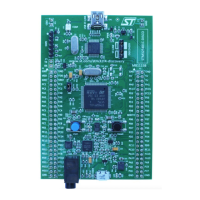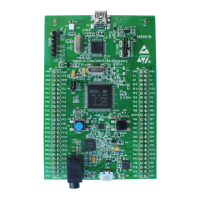Digital filter for sigma delta modulators (DFSDM) RM0402
370/1163 RM0402 Rev 6
14.4.11 Short-circuit detector
The purpose of a short-circuit detector is to signalize with a very fast response time if an
analog signal reached saturated values (out of full scale ranges) and remained on this value
given time. This behavior can detect short-circuit or open circuit errors (e.g. overcurrent or
overvoltage). An interrupt/event/break generation can be invoked.
Input data into a short-circuit detector is taken from channel transceiver outputs.
There is an upcounting counter on each input channel which is counting consecutive 0’s or
1’s on serial data receiver outputs. A counter is restarted if there is a change in the data
stream received - 1 to 0 or 0 to 1 change of data signal. If this counter reaches a short-circuit
threshold register value (SCDT[7:0] bits in DFSDM_CHyAWSCDR register), then a short-
circuit event is invoked. Each input channel has its short-circuit detector. Any channel can
be selected to be continuously monitored by setting the SCDEN bit (in DFSDM_CHyCFGR1
register) and it has its own short-circuit detector settings (threshold value in SCDT[7:0] bits,
status bit SCDF[3:0], status clearing bits CLRSCDF[3:0]). Status flag SCDF[y] is cleared
also by hardware when corresponding channel y is disabled (CHEN[y] = 0).
On each channel, a short-circuit detector event can be assigned to break output signal
dfsdm_break[3:0]. There are four break outputs to be assigned to a short-circuit detector
event. The break signal assignment to a given channel short-circuit detector event is done
by BKSCD[3:0] field in DFSDM_CHyAWSCDR register.
Short circuit detector cannot be used in case of parallel input data channel selection
(DATMPX[1:0] ≠ 0 in DFSDM_CHyCFGR1 register).
Four break outputs are totally available (shared with the analog watchdog function).
14.4.12 Extreme detector
The purpose of an extremes detector is to collect the minimum and maximum values of final
output data words (peak to peak values).
If the output data word is higher than the value stored in the extremes detector maximum
register (EXMAX[23:0] bits in DFSDM_FLTxEXMAX register), then this register is updated
with the current output data word value and the channel from which the data is stored is in
EXMAXCH[1:0] bits (in DFSDM_FLTxEXMAX register) .
If the output data word is lower than the value stored in the extremes detector minimum
register (EXMIN[23:0] bits in DFSDM_FLTxEXMIN register), then this register is updated
with the current output data word value and the channel from which the data is stored is in
EXMINCH[1:0] bits (in DFSDM_FLTxEXMIN register).
The minimum and maximum register values can be refreshed by software (by reading given
DFSDM_FLTxEXMAX or DFSDM_FLTxEXMIN register). After refresh, the extremes
detector minimum data register DFSDM_FLTxEXMIN is filled with 0x7FFFFF (maximum
positive value) and the extremes detector maximum register DFSDM_FLTxEXMAX is filled
with 0x800000 (minimum negative value).
The extremes detector performs a comparison after a right bit shift and an offset data
correction. For each extremes detector, the input channels to be considered into computing
the extremes value are selected in EXCH[3:0] bits (in DFSDM_FLTxCR2 register).

